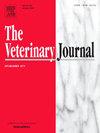四川山羊多杀性巴氏杆菌毒力基因和多重耐药率高
IF 3.1
2区 农林科学
Q1 VETERINARY SCIENCES
引用次数: 0
摘要
多杀性巴氏杆菌是山羊感染的重要病原体之一,给山羊养殖业造成了严重的经济损失。为了解山羊多杀假单胞菌的生物学特性,对来自四川山羊养殖场的342份鼻拭子和8份肺组织样本进行了细菌的综合鉴定。34株分离株分别为荚膜型D和脂多糖(LPS)基因型L3,表明D: L3是山羊养殖场的主要血清型。在34株分离株中鉴定出多个毒力相关基因,其中ompA、ompH、oma87、exbB和exbD基因的检出率为100 %(34/34)。值得注意的是,编码多杀p.a毒素(PMT)的toxA基因的患病率为85.2% %(29/34)。此外,抗菌药物敏感性试验显示多药耐药率较高,氨苄西林耐药率为41.1 %,四环素耐药率为38.2 %,卡那霉素耐药率为32.3% %。总之,本研究为了解山羊多杀假单胞菌的流行病学和耐药性提供了基础,为今后的防治措施提供了参考。本文章由计算机程序翻译,如有差异,请以英文原文为准。
High prevalence of virulence genes and multi-drug resistance in Pasteurella multocida from goats in Sichuan, China
Pasteurella multocida is one of the most important pathogens that infect goats, causing serious economic losses in the goat breeding industry. To understand the biological characteristics of P. multocida from goats, a comprehensive characterization of bacteria isolated from 342 nasal swabs and 8 lung tissue samples from goat farms in Sichuan, China, was performed. A total of 34 isolates were assigned to one capsular type, D, and one lipopolysaccharide (LPS) genotype, L3, indicating that the D: L3 was the predominant serotype in goat farms. In the 34 isolates, multiple virulence-related genes were identified, with a detection rate of 100 % (34/34) for the genes ompA, ompH, oma87, exbB, and exbD. It is noteworthy that the prevalence of the toxA gene, which encodes the P. multocida toxin (PMT), was found to be 85.2 % (29/34). Furthermore, antimicrobial susceptibility testing indicated a high prevalence of multidrug resistance, with resistance rates of 41.1 % for ampicillin, 38.2 % for tetracycline, and 32.3 % for kanamycin. Overall, this study provides a foundational understanding of the epidemiology and antimicrobial resistance of P. multocida in goats, offering insights for future prevention and control measures.
求助全文
通过发布文献求助,成功后即可免费获取论文全文。
去求助
来源期刊

Veterinary journal
农林科学-兽医学
CiteScore
4.10
自引率
4.50%
发文量
79
审稿时长
40 days
期刊介绍:
The Veterinary Journal (established 1875) publishes worldwide contributions on all aspects of veterinary science and its related subjects. It provides regular book reviews and a short communications section. The journal regularly commissions topical reviews and commentaries on features of major importance. Research areas include infectious diseases, applied biochemistry, parasitology, endocrinology, microbiology, immunology, pathology, pharmacology, physiology, molecular biology, immunogenetics, surgery, ophthalmology, dermatology and oncology.
 求助内容:
求助内容: 应助结果提醒方式:
应助结果提醒方式:


